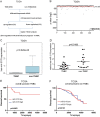miR-3178 inhibits cell proliferation and metastasis by targeting Notch1 in triple-negative breast cancer
- PMID: 30333478
- PMCID: PMC6192997
- DOI: 10.1038/s41419-018-1091-y
miR-3178 inhibits cell proliferation and metastasis by targeting Notch1 in triple-negative breast cancer
Abstract
Triple-negative breast cancer (TNBC) has a poorer outcome than other subtypes of breast cancer, and the discovery of dysregulated microRNA (miRNA) and their role in tumor progression has provided a new avenue for elucidating the mechanism involved in TNBC. In this study, we identified that miR-3178 was significantly reduced in TNBC, and the low miR-3178 expression correlated with poor overall survival in TNBC but not in non-TNBC. The ectopic overexpression of miR-3178 suppressed TNBC cell proliferation, invasion, and migration by inhibiting the epithelial-to-mesenchymal (EMT) transition. Notch1 was validated as the direct target gene of miR-3178, which was confirmed by the dual-luciferase reporter assay. miR-3178 decreased the expression of Notch1 and restoration of Notch1 expression attenuated the inhibitory effects of miR-3178 on cell proliferation, metastasis, and the EMT in TNBC. miR-3178 inhibited cell proliferation and metastasis by targeting Notch1 in TNBC, and the restoration of miR-3178 might be a potential therapeutic strategy for TNBC.
Conflict of interest statement
The authors declare that they have no conflict of interest.
Figures







Similar articles
-
MiR-508-3p inhibits cell invasion and epithelial-mesenchymal transition by targeting ZEB1 in triple-negative breast cancer.Eur Rev Med Pharmacol Sci. 2018 Oct;22(19):6379-6385. doi: 10.26355/eurrev_201810_16050. Eur Rev Med Pharmacol Sci. 2018. PMID: 30338806
-
MiR-92b inhibited cells EMT by targeting Gabra3 and predicted prognosis of triple negative breast cancer patients.Eur Rev Med Pharmacol Sci. 2019 Dec;23(23):10433-10442. doi: 10.26355/eurrev_201912_19682. Eur Rev Med Pharmacol Sci. 2019. PMID: 31841197
-
The Antimicrobial Peptide Merecidin Inhibit the Metastasis of Triple-Negative Breast Cancer by Obstructing EMT via miR-30d-5p/Vimentin.Technol Cancer Res Treat. 2024 Jan-Dec;23:15330338241281310. doi: 10.1177/15330338241281310. Technol Cancer Res Treat. 2024. PMID: 39267432 Free PMC article.
-
miRNA signatures affecting the survival outcome in distant metastasis of triple-negative breast cancer.Biochem Pharmacol. 2025 Jan;231:116683. doi: 10.1016/j.bcp.2024.116683. Epub 2024 Nov 27. Biochem Pharmacol. 2025. PMID: 39608504 Review.
-
Tumor Suppressive Role of MicroRNAs in Triple Negative Breast Cancer.Curr Pharm Des. 2023;29(42):3357-3367. doi: 10.2174/0113816128272489231124095922. Curr Pharm Des. 2023. PMID: 38037837 Review.
Cited by
-
A molecular approach to triple-negative breast cancer: targeting the Notch signaling pathway.Einstein (Sao Paulo). 2024 Feb 5;22:eRW0552. doi: 10.31744/einstein_journal/2024RW0552. eCollection 2024. Einstein (Sao Paulo). 2024. PMID: 38324848 Free PMC article. Review.
-
HIF-1-induced mitochondrial ribosome protein L52: a mechanism for breast cancer cellular adaptation and metastatic initiation in response to hypoxia.Theranostics. 2021 May 25;11(15):7337-7359. doi: 10.7150/thno.57804. eCollection 2021. Theranostics. 2021. PMID: 34158854 Free PMC article.
-
Nanomaterial-assisted CRISPR gene-engineering - A hallmark for triple-negative breast cancer therapeutics advancement.Mater Today Bio. 2022 Oct 4;16:100450. doi: 10.1016/j.mtbio.2022.100450. eCollection 2022 Dec. Mater Today Bio. 2022. PMID: 36267139 Free PMC article. Review.
-
The Anticancer Effects of Flavonoids through miRNAs Modulations in Triple-Negative Breast Cancer.Nutrients. 2021 Apr 7;13(4):1212. doi: 10.3390/nu13041212. Nutrients. 2021. PMID: 33916931 Free PMC article. Review.
-
The influence of selected microRNAs on the expression profile of genes and proteins related to the tumor necrosis factor-alpha signaling pathways in endometrioid endometrial cancer.J Cancer Res Clin Oncol. 2023 Sep;149(12):9679-9689. doi: 10.1007/s00432-023-04863-3. Epub 2023 May 26. J Cancer Res Clin Oncol. 2023. PMID: 37233761 Free PMC article.
References
-
- Gluz O, et al. Triple-negative breast cancer—current status and future directions. Ann. Oncol. 2009;20:1913–1927. - PubMed
-
- Dent R, et al. Triple-negative breast cancer: clinical features and patterns of recurrence. Clin. Cancer Res. 2007;13:4429–4434. - PubMed
-
- Weigelt B, Reis-Filho JS. Histological and molecular types of breast cancer: is there a unifying taxonomy? Nat. Rev. Clin. Oncol. 2009;6:718–730. - PubMed
Publication types
MeSH terms
Substances
LinkOut - more resources
Full Text Sources
Research Materials
Miscellaneous

